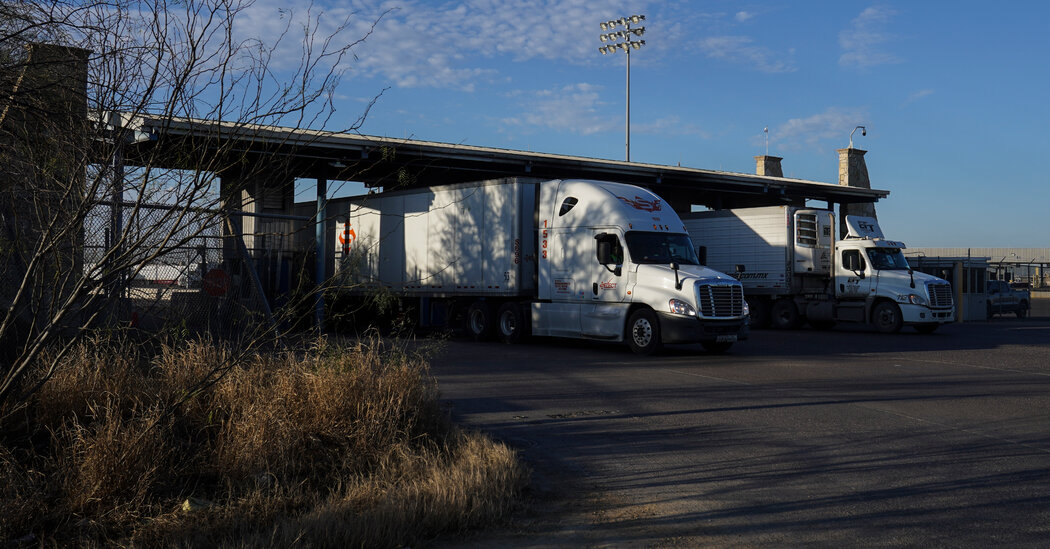President Trump’s tariffs target countries that are major suppliers of a wide range of goods to the United States. For American families, the likely result is higher prices nearly everywhere they turn — in grocery aisles, car dealerships, electronics stores and at the pump.
Mr. Trump on Saturday signed executive orders imposing tariffs on the country’s three largest trading partners, which are set to take effect at 12:01 a.m. Eastern time on Tuesday. All goods imported from Canada and Mexico will be subject to a 25 percent tariff, except Canadian energy products, which will face a 10 percent tariff, according to the executive orders. The orders also imposed a 10 percent tariff on Chinese goods.
While Mr. Trump on Sunday acknowledged that his new tariffs could cause “some pain,” he has insisted that they will not substantially increase prices for Americans and that foreign countries will bear the brunt. But trading data and economic studies suggest that consumers in the United States will probably see higher prices on wide range of products, from vegetables and meat to cellphones and cars. While some companies may opt against passing on the cost of the tariff, many are likely to raise prices on their products.
“Because of the combination of these three countries, it’s going to be difficult to go down an aisle of a grocery store and not see some sort of inflationary effect,” said Jason Miller, a professor of supply chain management at Michigan State University.
Here’s what to know about what prices could rise:
What should shoppers expect in the grocery aisles?
Fresh produce, much of which is imported from Mexico, is one of the first categories where shoppers might notice an uptick in prices, potentially within a couple of weeks of the tariffs going into effect. These items, including avocados, tomatoes and strawberries, have a short shelf life. Grocery stores lack substantial inventory, meaning that consumers will quickly find produce that is subject to Mr. Trump’s tariffs.
Price increases are poised to hit liquor aisles, too, especially beer and tequila. In 2023, nearly three quarters of U.S. agricultural imports from Mexico consisted of vegetables, fruit, beverages and distilled spirits, according to the U.S. Department of Agriculture.
The United States also imports a range of agricultural products from Canada, including meat and grains. Mr. Trump’s 25 percent tariff on most imports from its northern neighbor could push up retail prices for beef, if grocery stores pass the costs onto consumers.
This added burden comes as many Americans have already been experiencing sticker shock at their local supermarkets. Data from the Labor Department showed that in December, grocery prices — which were relatively flat in late 2023 and early 2024 — rose again, led by the price of eggs.
Could car prices increase, too?
Yes, the tariffs are widely expected to raise the prices that American consumers pay for new automobiles. That’s because auto manufacturers ship tens of billions of dollars worth of finished automobiles, engines, transmissions and other components each week across the U.S. borders with Canada and Mexico. Billions of dollars more are imported from parts manufacturers in China.
New cars and trucks are already selling for near record prices. Mr. Trump’s tariffs could add to the challenges for consumers looking to buy a car.
General Motors, the largest U.S. automaker, will probably feel the impact of the tariffs more acutely than other automakers. G.M. plants in Canada and Mexico produced nearly 40 percent of all vehicles the company made last year in North America.
But compared with food, how tariffs affect car prices will probably be more varied, said Mr. Miller of Michigan State University. Vehicles assembled in states including Michigan, Ohio, Kentucky and Indiana tend to rely heavily on auto parts imported from Canada, he said, which is not the case across the board.
“There’s just a lot more complexity to understanding increases in prices that consumers could eventually see,” Mr. Miller said.
What other products might be affected?
U.S. drivers, particularly in the Midwest, may see higher prices at the pump. Mr. Trump’s 10 percent tariff on Canadian energy is not as steep as he initially indicated it would be, and it’s lower than tariffs on other Canadian goods. But the tax nevertheless threatens to disrupt the U.S. oil and gas industry, which is highly dependent on Canadian oil. Roughly 60 percent of the oil that the U.S. imports comes from Canada.
Analysts expect the additional costs to be borne by a combination of oil producers in Canada and Mexico, U.S. refineries and American consumers. How the tariffs ripple through the market will depend in part on how long they remain in place.
Consumer electronics — among the top goods imported into the U.S. from China last year — could also get more expensive. From cellphones and computers to video games, shoppers could see prices start to rise within a couple of months.
Another product likely to be affected is lumber, about 30 percent of which is imported from Canada. Tariffs on softwood lumber could raise the cost of building houses, which risks worsening the housing affordability crisis that is already weighing on millions of American families. More than 70 percent of the imports of two essential materials that home builders rely on — softwood lumber and gypsum, which is used for drywall — come from Canada and Mexico, according to the National Association of Home Builders.
“Tariffs on lumber and other building materials increase the cost of construction and discourage new development, and consumers end up paying for the tariffs in the form of higher home prices,” Carl Harris, the chairman of association, said in a statement on Saturday.
How quickly could prices go up?
That depends on the product. Consumers could see a swift increase in prices for nondurable goods, including groceries. But it could take longer for prices to rise for durable goods, like cars, thanks to existing inventory, or if companies expect the tariffs to be temporary, said Felix Tintelnot, an associate professor of economics at Duke University.
How quickly firms are willing and able to raise their prices remains to be seen, Peter Simon, an economics professor at Northeastern University, said Saturday. While some price increases may represent a legitimate response to rising costs for businesses, there is also the risk of opportunistic pricing, meaning companies may use tariffs as an excuse to raise prices even more than necessary, Mr. Simon said.
What about across-the-board inflation?
Analysts at Goldman Sachs have said that if Mr. Trump proceeded with across-the-board tariffs, it would both raise prices in the United States and slow economic growth. Most economists expect that the fresh trade barriers could lead to a temporary burst of higher inflation.
Inflation has eased back down toward the Federal Reserve’s 2 percent target after the central bank raised interest rates aggressively in recent years and kept them at high levels. But the Fed remains alert to anything that could stall progress toward that goal — including Mr. Trump’s tariffs.


